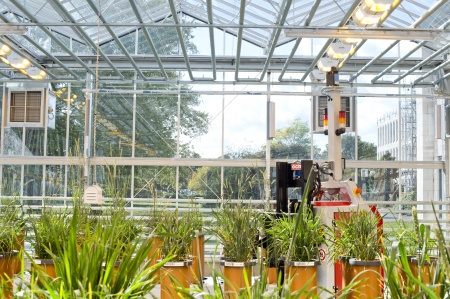
September 27, 2022, by Lexi Earl
Next Generation X-ray Computed Tomography system awarded to UoN Hounsfield Facility, boosting soil research capacity
Soils represent a major store of global carbon, much more so than that held in vegetation or the atmosphere. However, this reservoir of soil organic carbon (SOC) is highly susceptible to destabilisation and loss, leading to declines in soil health, loss of biodiversity, and nutrient capital, and the release of harmful greenhouse gases (GHGs). We therefore need to reduce current rates of soil organic carbon loss and ideally, reverse this trend. In order to understand how soil organic carbon is stored and degrades is crucial to the development of new approaches to mitigate climate change. It is necessary to quantify soil organic carbon in situ in soil. The ability to do this rapidly and microscopically is essential to this pressing work.
Current models of carbon mineralisation in soils that support climate change predictions ignore the heterogenous 3D structure of soil, even though it is widely known to regulate all soil processes. It is hoped that the spatially explicit inputs that future models need to address can be provided by the next generation of X-ray CT imaging. The University of Nottingham, through the research team at the Hounsfield Facility, has been awarded a new Next Generation X-ray Computed Tomography system (NxGen-XCT) by the Natural Environment Research Council (NERC) in a grant worth £720k to take on this challenge.
The Hounsfield Facility is the world’s leading centre for X-ray CT imaging for the plant and soil sciences. The new NxGen-XCT system represents a step-change in non-destructive 3D imaging for the environmental sciences community by providing researchers with a superior level of detail detectability, throughput and operational flexibility. The NxGen-XCT generates thousands of high-resolution images of the internal structure of any object, without the need for disturbance, which can then be used to generate 3D models. This ability to microscopically look inside a sample is a game changer for plant and soil sciences, particularly in the terrestrial and freshwater environments as well as atmospheric and climate sciences, ecology, geosciences, microbial sciences and pollution, waste and resources, as well as other disciplines. The system provides scanning of objects in minutes, a significant improvement on current capabilities, with enhanced image quality which supports easier object determination. The new detectability and automated capabilities of NxGen-XCT will overcome current limitations in CT scanning and support research to visualise materials like carbon, microplastics and potentially mycorrhizae in soils. This offers the opportunity for new scientific discoveries for research focused on root-soil-microbe interactions, and greater replication (possible due to an automated sample loader) and wider monitoring of system complexity and perturbation that is essential in environmental research.
Prof Sacha Mooney, Head of the Hounsfield Facility, commented: This new award adds to the tomography instruments already hosted at the Hounsfield Facility but importantly adds many new capabilities. Faster and higher quality imaging is something most users seek and we are excited to see how this will contribute not only to our current work in root-soil-microbe interactions but also a wider range of interdisciplinary projects that we collaborate on. The new funding also requires us to manage the new system as a NERC facility so we are excited to welcome members of the wider environmental sciences community to the Sutton Bonington campus who will no doubt be keen to test out the capabilities of the NxGen scanner.
The new NxGen-XCT will be available for use from the spring of 2023. Contact the Hounsfield team via Dr Craig Sturrock (Hounsfield Facility Manager) here.
No comments yet, fill out a comment to be the first

Leave a Reply